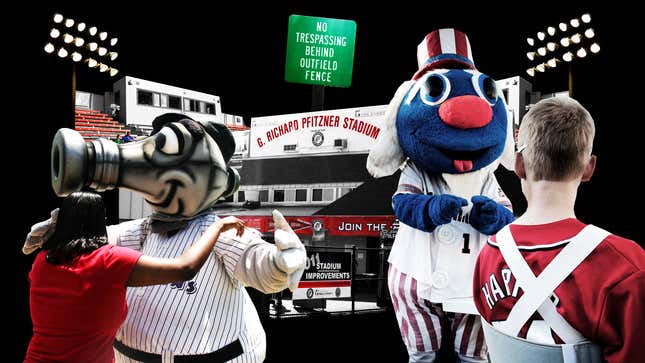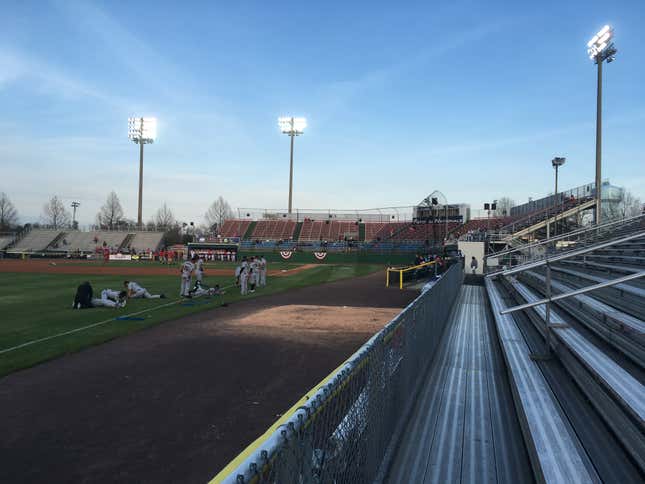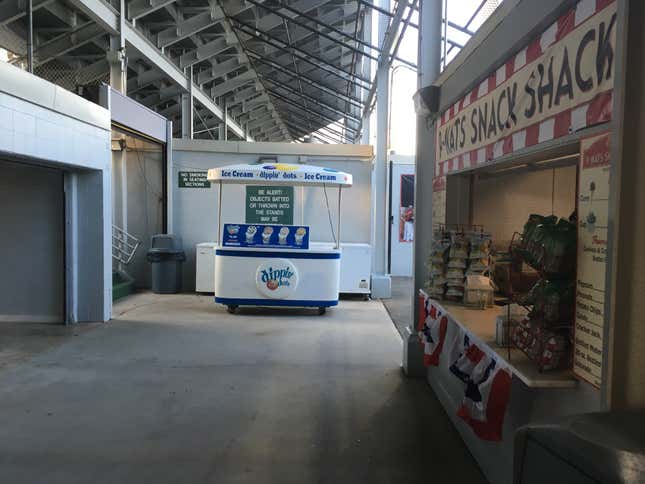
WOODBRIDGE, Virginia — None of the elite members of the Washington, D.C. sporting press were on hand at Pfitzner Stadium to witness the home opener of the Class-A Advanced Potomac Nationals. It was probably for the best.
It was one of those games where the box score at the end of night proves insufficient to express the true quality of the event. No ERA or batting average statistics can carve out a sense of what it felt like to be one of the lucky ones who made it out to catch the last ever home-opener at the stadium locals call The Pfitz.
Lucky is a weird word in this situation. The stadium opened in 1984, and in the years since it’s become one of the most rundown places to enjoy a ballgame. Before 2018, there weren’t even any fences or barriers separating the dugouts from the field of play. The facilities stink of gasoline. The PA is wrecked. The food is greatly diminished even from the Pizza Hut and curly fries of yesteryear. Even on Opening Day, the bathrooms were blighted with haggard toilets and busted soap dispensers.
Dwindling attendance and changing realities have informed a long-running debate about The Pfitz’s future that reached its conclusion last year, when the team announced it would be moving to Fredericksburg beginning in 2020. There, the logic goes, the team will regain its rightful place at the fringe of the suburbs, where families and ball fans are more apt to come out and enjoy a game.
The final Opening Day at the Pfitz on April 4 was a far cry from the creature comforts and high-caliber ball evident at Nationals Park, 22 miles distant. The shoddy facilities played host to an outright drubbing delivered at the hands of the Fayetteville Woodpeckers. You could have heard a dime drop in the grandstands up until the point when the crowd finally turned on the hometown heroes.
It’s hard to pinpoint the exact moment where the last iota of affection oozed out of the few sullen hundred who dotted the bleachers in the 6,000-seat stadium. Some may have lost faith prematurely, when the Woodpeckers put up four runs in the top of the third. Others gave up any hope of enthusiasm when a botched double play advanced a runner to third in the fourth. Even devout P-Nats fans must have winced when the pitcher subsequently balked in a run.
By the time Fayetteville’s Jake Adams hit a grand slam with no outs in the top of the fourth, and the inning’s first batter had come back up to bat and tacked on another triple for good measure, people who held season tickets since the park opened began to offer up grim prognostications for the subsequent 139 games.

I didn’t grow up at Pfitzner Stadium. (Even in Virginia, they’d call Child Protective Services on that.) But I did spend an inordinate amount of time sitting there along the third base line with my dad. For a few years, he’d put in for tickets to a smattering of Friday night games so he and his friend could sit and heckle an already nervous pack of 18-year-olds vying for a shot at the bigs. Back then, the team was the Single-A feeder for the Chicago White Sox. They were known as the Prince William Cannons—a nod to the Civil War battlefields down the road.
Clichéd as it may be, I feel duty bound to tell you that this was a different Northern Virginia. When The Pfitz was built, the sprawl of town homes and shopping malls that has earned the dismissive sobriquet, NoVa was still a limited periphery of post-war tract housing that didn’t stray far from the shoulders of D.C. before the region’s dominant country motifs became prominent.
The Nationals didn’t come to town until 2005. Before that, local baseball lovers had a choice—root for the Baltimore Orioles out of convenience, express some odd affiliation with the Atlanta Braves, or declare yourself a carpetbagging Yankees fan.
For many on the south side of the Potomac, the 60-mile jaunt to Camden Yards was cost- and time-prohibitive. Remember—this was long before the era of impressive cable TV viewing packages and online simulcasts. If you wanted to obsess over baseball, your options were limited. This was the heyday of The Pfitz.
It was a good time to be a Cannons fan, when the wonderment of youth was yet unsullied by the all-accessible world of portable dream screens. As a kid, The Pfitz seemed so big and marvelous. The stands bristled with fans that actually followed the game and cheered the players on. It was so busy, you had to come early on a Friday if you wanted a convenient spot in the gravel lot that arched around the belt of softball fields separating the cars and the park. I remember looking out at the vast patch of old Virginia forest that crowds the outfield walls at The Pfitz and wondering where all the dingers went. Were they just sitting out there in the woods, with the ticks and the raccoons?
There was always a horde of little ankle biters who crowded around the exits behind the third and first base lines, waiting to chase the few stray foul balls that would come their way every night. Down in the box seats (now a princely $17 ticket to sit well out toward the foul line), it was beneficial to bring a glove, should it need to be raised in order to prevent a head-high screamer from landing in one’s ear. That play wasn’t always executed safely. Once, a dear friend of mine took a Juan Thomas line drive to the skull. He’s fine now.
It wasn’t until my dad took me to see the Orioles’ minor-league team in Frederick, Maryland, that I realized The Pfitz provided an “intimate experience.” More than tiny, it was shabby—a rustic approximation of a ballpark. Something some high school sluggers would scoff at. An article of antiquarian athletic architecture built as a bridge between Northern Virginia’s rural heritage and its techno-future.
In the ensuing years, the area has changed vastly. When my family moved to Fairfax in 1991, the average price of a home was just over $204,000. By 2017, that number was somewhere around $580,000. Today, Northern Virginians live in the dull afterglow of a roaring Doppler shift in prosperity, by which the dot com boom and the post-9/11 defense boom exploded the cost of living and sent the prospect of inexpensive housing shuttling ever outward to the South and West.
What the changing suburbs failed to erode the foundations of the Single-A fan demographic, a proper team just 22 miles away in D.C. washed it away. Why tolerate sub-pro ball and a dinky stadium when you could sit beneath the lights at Nationals Park and watch the big guys play nine frames?

As The Pfitz gears down towards oblivion, it’s not hard to see why there would be a deficit of enthusiasm in the stands. The stadium feels like the Joad family’s jalopy, tasked with ferrying its mostly silent passengers through one last season before it will be abandoned. And yet, on Opening Day, the experience of watching a 69-pitch, eight-run half inning did have the unintended effect of getting the crowd into the action, if only for all the wrong reasons.
At game time, the absence of abundant church groups and little league teams that fill out the stands in the mid-summer made for a tinny echo when the national anthem crackled over a spotty public-address system, only to bounce off of the advertisements in the outfield and the empty lines of aluminum bleachers.
The few and the proud who dotted the stands like moles on a sun bather’s back offered little in the way of background noise. Even the standard burly voiced announcer abandoned his duties by the fourth in favor of a relief appearance by an amateur Harry Caray who sounded all of nine years old.
For a few innings, the most prominent sound in the stadium (beside sighs and the crack of Fayetteville’s bats) was the chatter of conversational Spanish bubbling out of the Woodpeckers’ dugout.
Until the mood changed. As the collective blood of the fans began to boil over the flame of the fourth-inning grand slam, single voices rang out with crystal clarity. One of the 12 or so people in section 3 sarcastically offered his services: “Hey, I used to pitch in little league.”
After the young arm subsequently gave up the triple, someone behind me screamed, “I believe in you, Pitch.” By the end of the inning, even the woman guiding fans to their box seats was yelling for the infield to “get it together.”
While sitting there, watching the home team come apart in a nearly empty and doomed stadium, receiving nothing but a chorus of grievances and bitter sarcasm from the few fans in attendance, I thought about what will be lost when The Pfitz is finally scraped from the landscape.
When I pay full freight to sit in the loge of a major-league park and watch the sport, I feel overcome by a certain feeling of the disingenuous. Maybe it’s all the mickey-mouse trappings of the experience economy, or the ways in which sabermetric impulses have reduced the sport to a sequence of 98-mph fastballs, resulting alternatively in strikeouts and home runs. It could also be the lingering sting of $15 beers and $20 parking.
Mostly though, I pine for an acknowledgement of how pristinely flawed the game of baseball is. To see the game played well can be a rewarding experience, but not the only one worth having. What The Pfitz has always offered is a chance to honor the silent-majority world of unglamorous ball, played in seedy has-been stops in unassuming towns across the globe.
Inauspicious as it may be, The Pfitz is a temple dedicated to a true form of baseball, one that revels in its long odds, hard breaks, and outright jankiness. For every winner that comes through the Carolina League, from Rick Ankiel to Elvis Andrus, there are dozens more who will never grasp glory.
Sitting in the stands, I began to wonder who of the forgotten thousands who ever played at The Pfitz realized that their shot at fame would end here. How many players passed countless innings in the dugout, or the unprotected bullpens, dreaming of a day that would never come?

One day soon, the lights will dim at The Pfitz for the last time. The team will move and some entrepreneur will slip in during the wee hours of the morning to pull out as much copper wiring as they can before the wrecking ball comes. There won’t be any plaque, no leftover championship banners. Nobody will auction off seats or save bricks from the team office (possibly because the original office blew up in 2012 due to a gas leak). No one will care.
Instead, those of us who were introduced to the game while sitting in the grubby confines of The Pfitz, watching a bunch of earnest kids play with a few future legends sprinkled in, will have to content ourselves with the knowledge that we saw the sport as it was intended to be played, and still mostly is—close, cheap, flawed and full of hope, however misguided.
Dan Johnson’s work has appeared in Salon, LA Times, and LA Weekly. He lives and works in downtown LA, three blocks away from where his great-grandfather, Johnny Bassler, got his crack at the majors. You can yell at him on twitter @catawampusland or pay him money for his book at mercatorrerejection.com